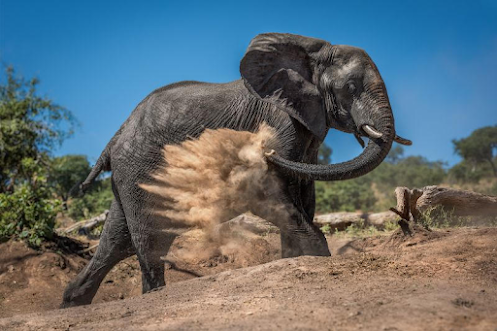Planning a safari in Tanzania? Whether you're tracking the awe-inspiring Great Migration in the Serengeti or exploring the wildlife haven of Ngorongoro, packing the right gear is essential for an unforgettable adventure. Here's your ultimate checklist, designed with both comfort and practicality in mind.
Clothing: Stay Cool,
Comfortable, and Safari-Ready
o Neutral-Colored Outfits
o Think khakis, beiges, and
greens. These colors keep you camouflaged and avoid attracting insects like
tsetse flies (skip the blues and blacks!).
o Long-Sleeve Shirts and Pants
o Perfect for cool mornings and
evenings while keeping bugs at bay. Lightweight, breathable fabrics are a must.
o Comfy Shorts and T-Shirts
o Great for those sunny daytime
game drives.
o Fleece or Warm Jacket
o Essential for those chilly dawn
game drives—especially if you’re heading to higher altitudes like Ngorongoro
Crater.
o Rain Jacket or Poncho
o A lifesaver during the rainy
season (March–May and November).
o Wide-Brimmed Hat
o Protects your face and neck
from Tanzania’s strong sun.
o Sturdy Shoes
o Lightweight hiking boots or
trainers are perfect for walking safaris or uneven terrain.
o Relaxing Sandals
o Slip into these at the lodge
after a day of adventure.
Safari Essentials: Gear Up for
the Wild
o Binoculars
o Don’t miss that leopard
lounging in the distance! Invest in a good pair.
o Daypack
o Pack your water, sunscreen,
camera, and snacks for the day.
o Camera & Extras
o A decent camera with extra
batteries and memory cards is a must for capturing those jaw-dropping moments.
o Reusable Water Bottle
o Stay hydrated while being
eco-friendly.
o Flashlight or Headlamp
o Campsites and lodges can get
dark—this will save the day (or night!).
o Power Bank
o Keep your phone and camera
charged even in remote areas.
Personal Care: Protect Yourself
& Stay Comfortable
o Sunscreen (High SPF)
o The African sun is no joke.
Reapply regularly!
o Insect Repellent
o A must to keep mosquitoes and
other bugs away. DEET-based or natural options work.
o Lip Balm with SPF
o Protect your lips from drying
out.
o Travel-Sized Toiletries
o Include essentials like
shampoo, soap, toothbrush, and hand sanitizer.
o First Aid Kit
o Stock it with Band-Aid’s, pain
relievers, antihistamines, and any personal medications.
o Anti-Malarial Medication
o Consult your doctor and be
prepared for regions where malaria is prevalent.
Keep your Documents &
Finances: Stay Organized
o Passport & Visa
o Ensure your passport is valid
for at least six months. Check visa requirements before you go.
o Yellow Fever Vaccination Card
o Required if traveling from
certain countries.
o Travel Insurance
o Covers medical emergencies and
unexpected trip changes.
o Cash (USD & Tanzanian
Shillings)
o US dollars are widely accepted,
but local currency is handy for smaller purchases.
o Digital & Physical Copies
of Important Docs
o Backup your passport, tickets,
and insurance details just in case.
Optional Add-Ons: For Extra
Comfort and Fun
o Lightweight Scarf or Buff
o Shields you from dust on game
drives.
o Snacks
o Energy bars or dried fruits for
long drives.
o Notebook or Journal
o Capture your daily safari
adventures in writing.
o Books or an E-Reader
o Perfect for downtime at the
lodge.
Top Tip: Pack Light!
Safari vehicles and small planes often have
weight limits for luggage, so stick to a soft-sided duffel bag and keep it
under 15 kg (33 lbs). With this list, you’ll be prepared to enjoy every
moment of your safari—from dawn game drives to evenings by the campfire.
What to Pack for Climbing Mount
Kilimanjaro: Complete Packing List
Climbing Mount Kilimanjaro is an unforgettable
adventure, but it requires proper preparation. From high-altitude gear to
layered clothing, packing the right items is essential for staying comfortable
and safe during your trek. Here’s your ultimate Kilimanjaro packing guide:
Clothing: Dress for All Weather
Conditions
o Base Layers
o Thermal Underwear: Lightweight, moisture-wicking
base layers for warmth.
o Long-Sleeve Shirts & Pants: Lightweight, breathable
fabrics that wick away sweat.
o Mid-Layers
o Fleece Jacket or Pullover: Provides warmth in the cold
weather, especially at higher altitudes.
o Insulated Jacket: A down or synthetic jacket
for colder conditions.
o Outer Layers
o Waterproof Jacket & Pants: Protects against rain and
wind.
o Windbreaker: Keeps you warm and shields
you from the elements.
o Hats & Gloves
o Sun Hat: Protects your face and neck
from the sun.
o Warm Beanie or Hat: Essential for colder
altitudes.
o Gloves: Light gloves for trekking and
a pair of warmer gloves for summit night.
o Trekking Pants & Shorts
o Lightweight Pants: Quick-drying and breathable
materials for trekking.
o Comfortable Shorts: For lower altitudes or during
the day.
Footwear: Sturdy and
Comfortable for the Climb
o Trekking Boots
o High-quality, waterproof boots
with ankle support to handle rugged terrain. Break them in before the trek!
o Gaiters
o Useful for protecting your
boots and pants from dust, snow, and mud.
o Lightweight Hiking Shoes
o Comfortable for wearing around
camp after a day of trekking.
o Thick Wool Socks
o Bring several pairs to avoid
blisters. Wool socks are excellent for regulating temperature and moisture.
Accessories: Stay Safe and
Comfortable
o Headlamp with Extra Batteries
o Essential for early starts or
evening activities.
o Sunglasses with UV Protection
o Protect your eyes from glare
and UV rays at high altitudes.
o Sun Protection
o Sunscreen (High SPF): Prevent sunburn, especially
in high-altitude conditions.
o Lip Balm with SPF: Essential to prevent chapped
lips.
o Water Bottle / Hydration System
o Stay hydrated with a reusable
water bottle or hydration pack.
o Trekking Poles
o Help to reduce strain on your
knees and improve stability on steep sections.
o Personal Medications
o Bring any necessary
prescriptions, as well as over-the-counter pain relievers and altitude sickness
prevention medication.
Sleeping Gear: Comfort During
Your Climb
o Sleeping Bag
o Rated for cold temperatures
(around -10°C or 14°F), as it can get quite chilly at higher altitudes.
o Sleeping Pad
o Provides extra comfort for
camping on rocky terrain.
o Pillow
o A small inflatable or
compressible pillow for added comfort at camp.
Personal Items: Essentials for
Your Kilimanjaro Journey
o Passport & Copies
o Keep your passport safe, but
have a copy for emergencies.
o Travel Insurance
o Make sure it covers trekking at
high altitudes and emergencies.
o Cash for Tips & Souvenirs
o Bring a small amount of local
currency or USD for tips or purchases.
o Camera & Extra Batteries
o Capture breathtaking views—but
remember to keep batteries charged!
o Notebook/Journal
o Record your thoughts and
experiences during the climb.
Optional Items: Extras for
Comfort and Convenience
o Snacks
o High-energy snacks like trail
mix, granola bars, or dried fruit for quick bursts of energy.
o Hand Warmers
o Keep your hands warm during
summit night.
o Binoculars
o Spot wildlife or take in the
incredible views on your way up.
Top Tips for Kilimanjaro
Trekkers
o Layer Your Clothing: Weather can change quickly,
so it’s important to dress in layers.
o Pack Light: The lighter your bag, the
better your climb. Your porter will carry your main gear, but you’ll want to
keep your daypack light.
o Hydrate & Acclimatize: Drink plenty of water to help
avoid altitude sickness and give your body time to adjust to the high altitudes.
By following this packing list, you’ll be
fully prepared to conquer Mount Kilimanjaro and enjoy every step of the
journey. Ready to take on the Roof of Africa? Get in touch with us today to
start planning your Kilimanjaro trek and perfect Tanzania Safari!





